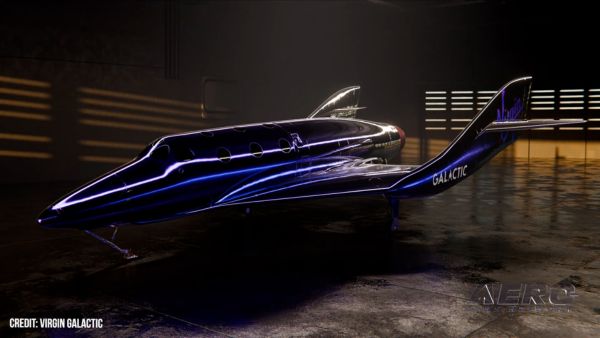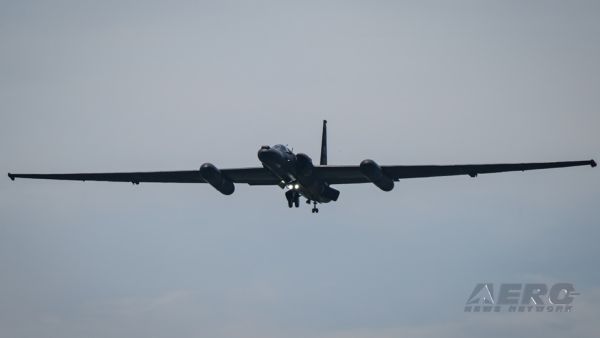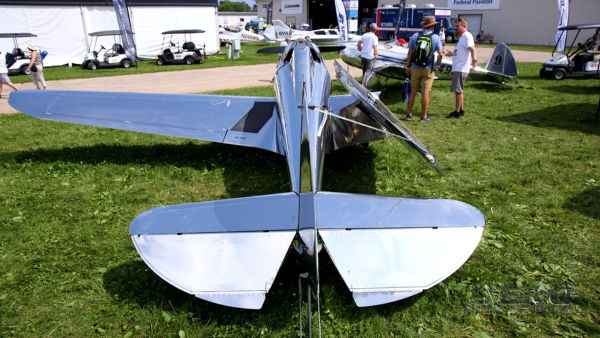by Jon Thornburgh, Ultralight Flight Instructor
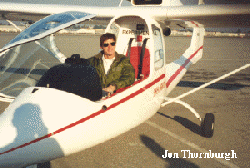 I often receive telephone inquiries from
prospective students who believe they would like to fly ultralights
because they are more "affordable" than general aviation airplanes.
Unfortunately, the caller is shocked to learn that the cost of
ultralight instruction is $80 per hour for the airplane and
instructor. The typical response is, "How can it cost so much? I
thought that ultralight flying was cheap!"
I often receive telephone inquiries from
prospective students who believe they would like to fly ultralights
because they are more "affordable" than general aviation airplanes.
Unfortunately, the caller is shocked to learn that the cost of
ultralight instruction is $80 per hour for the airplane and
instructor. The typical response is, "How can it cost so much? I
thought that ultralight flying was cheap!"
This leads into a lengthy discussion of the relative costs of
ultralight flying, versus general aviation flying and other
activities. Before getting into the cost specifics, there are a
couple of axioms that I'd like to state at the beginning.
First axiom: there is no form of aviation that
is "cheap." If you want a less-inexpensive sport, you'll have to
take up jogging, surfing, tennis, or maybe bowling. Relatively
speaking, anything in aviation is going to be more expensive than
most other endeavors.
Within the field of aviation, there are degrees of expense,
depending on the type of flying you're involved in. Flying a
helicopter or a personal jet are at the high end of the dollar
scale. Flying an ultralight is at the lower end, but it is still
not "cheap."
Probably the most affordable way to get into the air is hang
gliding. But even hang gliding is not "cheap." Hang glider wings
today are very sophisticated. And expensive. It's not uncommon for
wings to cost $3000 or more. Plus, there is the cost of driving to
the launch site, and the cost of training.
There is also the expense of joining the U.S. Hang Gliding
Association, if you want to fly at sanctioned locations. And don't
forget the cost of your divorce when your spouse leaves in disgust
at your inexplicable newfound craving for danger.
Second axiom: The cost of flight instruction is
always more expensive than the cost of flying after you are a
trained pilot. The $80 per hour quoted in the first paragraph is
for flight instruction, not solo flight. As we'll see near the end
of this article, the distinction between personal flying and flight
instruction is significant.
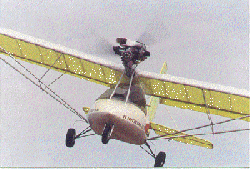 Third
axiom: under the right circumstances, ultralight flying
can be less expensive than general aviation. Many ultralight
advertisements and magazine articles emphasize that ultralight
flying is affordable. Is this the truth or not? The answer is
"yes," it is true, but only under specific circumstances.
Third
axiom: under the right circumstances, ultralight flying
can be less expensive than general aviation. Many ultralight
advertisements and magazine articles emphasize that ultralight
flying is affordable. Is this the truth or not? The answer is
"yes," it is true, but only under specific circumstances.
Those circumstances are these: you are a pilot, not a student; you
purchase your own your flying machine (instead of renting); the
ultralight you own is a single-seat, you do the maintenance and
upkeep yourself, you don't buy insurance, and you keep the
ultralight on your own property. If you adhere to the conditions
just delineated, then ultralight flying is pretty "cheap."
Otherwise, it's not.
How much is "cheap" under these conditions?
You can probably buy a pretty good single-seat ultralight for
about $10,000 brand new. You can buy a used one for less.
The cost-per-hour for fuel and oil is between $6 to $10, depending
on the size and horsepower of the engine, and whether you operate
it at a low or high power setting. The cost for routine maintenance
and replacement parts for wear and tear is about $5 per hour.
Routing maintenance includes such things as new spark plugs, oil
for the gear reduction drive, and new tires and brakes.
Deferred maintenance costs include engine overhaul, replacement of
the wing covering due to ultraviolet deterioration and repairs due
to hard landings or other abuse, such as hitting a wing against the
hangar.
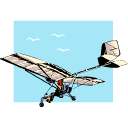 Rotax™ makes the most popular ultralight engine. The
recommend overhaul time for the (ultralight-size) Rotax engine is
300 hours. Depending on the size and horsepower of the engine, the
cost of the 300-hour overhaul is approximately $1500 to $2000.
Hirth, 2si (formerly Cuyuna), and other engine manufacturers have
similar overhaul times, generally varying from 300 to 500 hours.
The overhaul time is referred to in pilot-talk as the "TBO" (Time
Between Overhauls). If the 300-hour overhaul were to cost $1500,
that amounts to $5 per hour, which must be put aside in reserve for
the engine TBO.
Rotax™ makes the most popular ultralight engine. The
recommend overhaul time for the (ultralight-size) Rotax engine is
300 hours. Depending on the size and horsepower of the engine, the
cost of the 300-hour overhaul is approximately $1500 to $2000.
Hirth, 2si (formerly Cuyuna), and other engine manufacturers have
similar overhaul times, generally varying from 300 to 500 hours.
The overhaul time is referred to in pilot-talk as the "TBO" (Time
Between Overhauls). If the 300-hour overhaul were to cost $1500,
that amounts to $5 per hour, which must be put aside in reserve for
the engine TBO.
Let's add up the costs so far: $6 for fuel and oil, plus $5 for
routine maintenance, plus $5 reserve for the engine TBO equals $16
per flight hour.
This $16 does not take into account the lost income that could have
been generated if you had invested the purchase price of the
ultralight in something like a Certificate of Deposit (CD), instead
of buying the flying machine. If you had put the $10,000 into a CD
paying 5% or so, it would have yielded $500 per year [nearly
6¢ an hour --ed].
Realistically, a moderately active ultralight pilot typically flies
about 100 hours per year. At 100 hours per year, that "lost" $500
comes to $5 per hour of flight time. Add another $5 to the $16 and
the cost of flying a typical $10,000 ultralight for 100 hours per
year comes to $21 per hour, or $2100 for the year.
Other costs
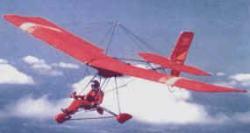 Most ultralight wings and powered-parachute
canopies are made of Dacron. Unfortunately, ultraviolet rays from
sunlight causes Dacron to deteriorate. The recommended sunlight
exposure is 2000 hours before replacement. This means that if you
were to keep your ultralight outdoors, and unprotected from the
sun, the fabric would deteriorate in eight months. That's why it's
so important to keep the ultralight in a hangar, or cover the
wings. (Wing covers cost about $500.)
Most ultralight wings and powered-parachute
canopies are made of Dacron. Unfortunately, ultraviolet rays from
sunlight causes Dacron to deteriorate. The recommended sunlight
exposure is 2000 hours before replacement. This means that if you
were to keep your ultralight outdoors, and unprotected from the
sun, the fabric would deteriorate in eight months. That's why it's
so important to keep the ultralight in a hangar, or cover the
wings. (Wing covers cost about $500.)
The covering on the wing is referred to as a "sail," since it made
out of the same fabric as the sails on a boat. The cost of new wing
sails varies greatly, depending on the type of flying machine (a
trike vs. an airplane, for example,) the size of the wing, and
whether it has multiple colors or not. However, a ballpark figure
for new sails is $1500 to $2000. The cost can be even higher, if
the air-plane fuselage, in addition to the wing, is covered with
Dacron, such as the Buccaneer seaplane.
Fortunately, the life of the fabric can be extended by coating it
with a protective paint, such as PPG. This will just about double
the lifetime of the fabric. However, the coating itself can be
expensive, especially if it professionally sprayed on the fabric at
a paint shop.
Let's say, for the sake of argument, that you leave your airplane
outdoors and without protection (no wing cover or UV-resistant
paint.) This would mean that you would have to replace the fabric
about once a year. At a replacement cost of $1500, the amount of
money that you would have to put into reserve for the new sail
would come to $15 per hour, if you fly 100 hours a year. Add
another $15 to the previously calculated $21 per hour, and the
total now comes to $36 per hour, including the direct costs and a
maintenance reserve. As I said in the beginning of this article, no
form of flying is "cheap."
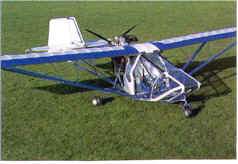 Of course, if you cover your ultralight or keep it
in a hangar, the sails will last much longer. If the only time that
the fabric is exposed to sunlight is during the time that you are
actually in flight, that means that the sails would accrue 100
hours of exposure per year. In that case, the fabric could
theoretically last for 20 years, not taking into account
deterioration due to pollution in the air or rough handling. The
100 hours of exposure per year would add up to about $1 for each
hour of flight time. The $36 figure stated in the previous
paragraph now drops to $22, a significant difference.
Of course, if you cover your ultralight or keep it
in a hangar, the sails will last much longer. If the only time that
the fabric is exposed to sunlight is during the time that you are
actually in flight, that means that the sails would accrue 100
hours of exposure per year. In that case, the fabric could
theoretically last for 20 years, not taking into account
deterioration due to pollution in the air or rough handling. The
100 hours of exposure per year would add up to about $1 for each
hour of flight time. The $36 figure stated in the previous
paragraph now drops to $22, a significant difference.
However, you must factor the cost of the hangar back into the
equation. Let's say that you live on a farm, and have your own
airstrip for takeoffs and landings. You could buy a so-called
"portable" hangar from a company such as Cover-it™ for about
$3000. Keeping your airplane in your own hangar would definitely
reduce the wear and tear on your ultralight. Assuming a loss of a
potential 5% interest on the $3000 if you had invested the hangar
money, that comes to $150 per year, or $1.5 per flight hour. Add
the $1.5 to the $22 in the previous paragraph, and the cost now
becomes $23.50 per hour.
Unfortunately, most people don't live on a farm. Therefore, you
will have to rent a hangar at an airstrip. That can be really
expensive. In some areas in California, hangars go for $300 per
month. A more typical figure throughout the country is $30 to $50
per month. Let's say you can find a hangar to rent for the
rock-bottom price of $20 per month. That comes to $240 per year, or
$2.40 per hour for 100 hours of flight time per year. Adding the
$2.40 to the previous sub-total of $22 equals $24.40 per hour. If
the hangar were $30 per month, the total comes to $25.60 per hour.
If the hangar were the California-priced $300 per month, the total
is a whopping $58 per hour!
Instead of hangaring the ultralight, if you buy a protective cover
for the wings, the cover itself only lasts about two years. That
costs about $250 a year, or $2.50 per flight hour, which is the
same cost as a $20-per-month hangar.
Covers are not nearly as effective in protecting the airplane,
since there seems to always be some part of the wing sail which
remains exposed to the sun. (Don't forget that you need to cover
the tail and elevators, too.) In addition, the wind rubs the cover
against the Dacron and causes abrasions. The cover is also a real
nuisance to put on and off, sometimes taking up to an hour if it is
windy and you are working without someone to help you.
Subject to change...
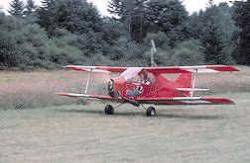 All of these calculations have been based on a
theoretical 100 hours of flight time per year. The hourly rate
would change dramatically if you flew 200 hours, or only 50 hours.
That's why it's difficult to accurately tell someone how much it
will cost per hour to fly an ultralight. If you fly several hundred
hours per year, the hourly cost could drop to a minimum of
approximately $20 per hour. (We know that the direct cost of fuel
and oil is $6 to $10 per hour. Add $5 for routine maintenance, and
the mini-mum hourly direct cost is $11 to $16.)
All of these calculations have been based on a
theoretical 100 hours of flight time per year. The hourly rate
would change dramatically if you flew 200 hours, or only 50 hours.
That's why it's difficult to accurately tell someone how much it
will cost per hour to fly an ultralight. If you fly several hundred
hours per year, the hourly cost could drop to a minimum of
approximately $20 per hour. (We know that the direct cost of fuel
and oil is $6 to $10 per hour. Add $5 for routine maintenance, and
the mini-mum hourly direct cost is $11 to $16.)
The rest of the fixed costs include the engine overhaul, possible
aircraft damage repair, sail replacement, hangar or airport
tie-down fees, lost interest income on your purchase price, and the
cost of insurance (if you buy insurance.)
Other variable fees include the initial cost of your training, the
extra premium that you must pay to keep your life insurance in
effect while flying, driving to and from the airport (which might
be a considerable distance away) the cost of flight equipment such
as helmets, protective clothing, handheld GPS receivers, portable
gas cans, et cetera, magazine subscriptions, membership in an
ultralight organization or club, and so on. And of course, don't
for-get the cost of your divorce.
The bottom line is that the cost of flying your own single-seat
ultralight can vary from a low of approximately $20 up to as much
as $60 per hour, depending on a confluence of all the factors
mentioned above. I'd say a reason-able average figure would be $25
per hour, which is pretty inexpensive by general aviation
standards.
Actually, $25 per hour is pretty reasonable compared to many other
sports. Compare it to the cost of ski lift tickets, scuba diving
excursions, water skiing, and even hourly golf lessons.
So why is instruction so relatively expensive?
Because, it's something else entirely.
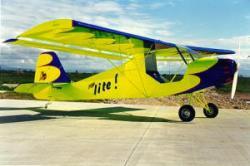 What
about the cost of ultralight instruction? Remember in the first
paragraph when I quoted a figure of $80 for instruction? Why is it
so much? The reason is because the cost of running a professional
flight school is much higher than it is for the pilot who simply
flies his own ultralight.
What
about the cost of ultralight instruction? Remember in the first
paragraph when I quoted a figure of $80 for instruction? Why is it
so much? The reason is because the cost of running a professional
flight school is much higher than it is for the pilot who simply
flies his own ultralight.
First of all, the flight instructor has all the same expenses as
the private owner: fuel, oil, maintenance, sail replacement,
tie-down fees, hangar costs, and so on. Add to that the cost of
advertising, business and liability insurance, office rental, the
business license, record keeping, accounting and tax preparation,
and telephone bills. Plus, the instructor has to make at lease some
profit, or he can't pay alimony to his ex-wife.
In addition, the cost of a two-seat ultralight trainer is much more
expensive than a single-seat ultralight. The purchase price of a
trainer is $20,000 to $30,000. Plus, the cost of maintenance is
much higher, due to the large number of bounced landings that
students make. Most train-ers do not have a strong landing gear
suspension system, so such things as bent axles are common. At $200
per replacement, the bill adds up.
The FAA requires all flight instructors to be a member of, and
licensed by, a nationally recognized ultralight organization. The
membership fee varies with the different organizations, but it
comes to at least $150 per year. The instructor must also attend
recurrent training, which can add up to several hundred more
dollars, counting travel and hotel bills.
If the instructor maintains the aircraft himself, he will likely
attend an engine maintenance course. A three-day course offered by
Rotax costs $400. Again there is the transportation and hotel
expense. If the instructor doesn't do his own maintenance, then he
must pay a mechanic to do it. That's a big expense.
The instructor must have much more flight experience than a
non-instructor. That extra flight time costs a lot of money. Plus,
the instructor must pay for the training required to become an
instructor, and pay for an Examiner who administers a flight test.
It can easily cost several thousand dollars to become an ultralight
instructor.
Basically, the ultralight school has all the same expenses as a
general aviation flight school. The only expense which is slightly
lower is a somewhat less expensive airplane and marginally lower
fuel cost.
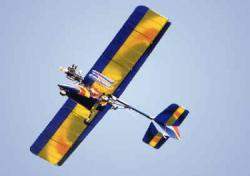 When a
student pays for his flight training he is not only paying for the
rental of the flying machine, he is also paying for the
instructor's time and skill. Many ultralight instructors actually
charge more for their instruction than FAA-certified instructors
(CFIs) do. Why? Because many CFIs are willing to teach practically
for free in order to built up flight time to go to the airlines
where they can make the big bucks.
When a
student pays for his flight training he is not only paying for the
rental of the flying machine, he is also paying for the
instructor's time and skill. Many ultralight instructors actually
charge more for their instruction than FAA-certified instructors
(CFIs) do. Why? Because many CFIs are willing to teach practically
for free in order to built up flight time to go to the airlines
where they can make the big bucks.
Ultralight instructors, however, have no hope of getting an airline
pilot's job, because ultralight instruction cannot be logged as
FAA-certified flight time. Therefore, the ultralight instructor
must actually make a living from his teaching profession. In my
opinion, an ultralight instructor is much more likely to be
teaching for the joy of flying than a CFI is.
Hopefully, a prospective ultralight enthusiast now has a better
idea of the actual cost of owning an ultralight and the cost of
obtaining instruction. Maybe someday, we'll be able to strap on
angel wings or anti-gravity belts, and be able to fly practically
for free. But until then, we'll have to pay the price to experience
the exhilaration and freedom of flight.
To me, the price is well worth it.
Jon Thornburgh is an FAA CFI, an ultralight instructor, and writes
for several aviation magazines, as well as being ANN's Ultralight
Columnist.
 Classic Aero-TV: The Legend Cub-Just a Little Bit Better than the Original Cub
Classic Aero-TV: The Legend Cub-Just a Little Bit Better than the Original Cub ANN's Daily Aero-Term (08.09.25): Decision Altitude (DA)
ANN's Daily Aero-Term (08.09.25): Decision Altitude (DA) Aero-News: Quote of the Day (08.09.25)
Aero-News: Quote of the Day (08.09.25) ANN's Daily Aero-Linx (08.09.25)
ANN's Daily Aero-Linx (08.09.25) Aero-News: Quote of the Day (08.10.25)
Aero-News: Quote of the Day (08.10.25)








